




The Internet today works much like a vast and rapidly expanding city. Every device — whether it’s your phone, laptop, or home router — needs a unique address to send and receive information. For decades, this addressing system depended on IPv4, a 32-bit structure that was perfectly adequate when the Internet was small.
However, as more people, devices, and services connected online, IPv4’s supply of addresses could no longer keep up with the growth. This shortage triggered the introduction of temporary workarounds and long-term solutions — the most significant being Carrier-Grade NAT (CGNAT) and IPv6.
To extend the lifespan of IPv4, many Internet Service Providers (ISPs) adopted Carrier-Grade NAT. Instead of assigning every user a unique public IP address, CGNAT enables multiple customers to share a single IP. Each household receives a private internal address, and a translation layer maps internal traffic to the shared public IP.
This approach successfully delayed IPv4 exhaustion, but it introduced several limitations. CGNAT disrupts the Internet’s original end-to-end communication model by placing translation devices in the middle of user connections. As a consequence, certain applications struggle to function correctly, especially those that rely on direct connectivity.
Port forwarding becomes extremely difficult, sometimes impossible. This affects use cases such as home servers, online gaming, peer-to-peer applications, remote access setups, and more. Additionally, when multiple users share the same public IP, identifying the source of spam, abuse, or cyberattacks becomes far more complex. These challenges make CGNAT a useful but imperfect solution.
IPv6 was created as a permanent and future-proof alternative to IPv4. With its 128-bit address space, IPv6 provides an enormous pool of unique public addresses — enough for every device on Earth and many more.
Unlike CGNAT-based IPv4 setups, IPv6 supports true end-to-end connectivity. Every device can be globally reachable without relying on NAT layers or port mapping workarounds. This leads to cleaner network designs, lower complexity, improved reliability, and better performance for applications that require direct communication.
Despite its advantages, IPv6 adoption has been slower than expected. Many networks still run primarily on IPv4 infrastructure, and not all devices or applications fully support IPv6. In some cases, IPv6 is deployed using the same philosophies as IPv4 NAT, reducing the benefits of the protocol due to outdated design assumptions.
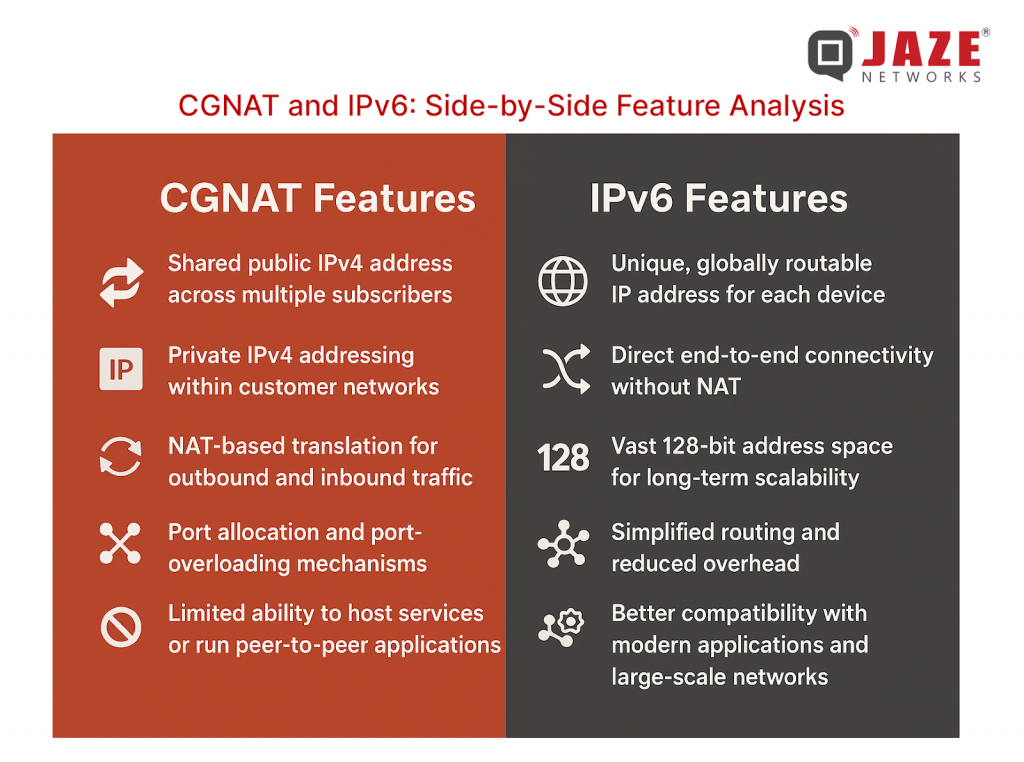
The differences between CGNAT and IPv6 become clear when examining common real-world scenarios:
In essence, CGNAT introduces friction for modern, interactive Internet use cases, while IPv6 aligns naturally with today’s connectivity needs.
Migrating an entire global Internet ecosystem is complex. Several factors slow down IPv6 deployment:
To move forward, ISPs must embrace native IPv6 routing instead of leaning on NAT-based stopgaps. Device manufacturers and service providers should treat IPv6 compatibility as mandatory, not optional. Developers and technical professionals need to adopt IPv6-first design principles to ensure smooth interoperability.
CGNAT has played an important role in extending the life of IPv4, but its limitations are increasingly apparent. It complicates connectivity, affects performance, reduces transparency, and restricts how users interact with the Internet.
IPv6, by contrast, provides scalability, efficiency, and true end-to-end communication — all essential for the modern digital ecosystem. While the transition is ongoing, IPv6 represents the Internet’s long-term foundation.
For users who rely on hosting, gaming, remote access, or advanced networking features, choosing an ISP that offers robust, native IPv6 routing can significantly improve their experience. For technology creators and providers, adopting IPv6-first development ensures long-term compatibility and reliability.
Ultimately, the future of the Internet is built on abundant addressing, simplified routing, and open connectivity — the principles that IPv6 was designed to deliver.
Jaze ISP Manager offers comprehensive solutions to help ISPs transition seamlessly to IPv6 with integration with all major BNG providers ensuring robust network performance and future-proof connectivity.
API (Application Programming Interface) integration allows different software applications to exchange information seamlessly—and that matters a lot for Internet Service Providers (ISPs).
Consider this scenario: A new subscriber signs up via your mobile app, their account is created in your billing system, the network gateway provisions their service, and the CRM logs the sale—all in real time. Without API integration, this flow involves manual steps, delays, errors, and lots of overhead. With it, everything happens automatically.
For ISPs, that means faster onboarding, fewer customer issues, lower operational costs, and better scalability. As access technologies diversify (fiber, WiFi 6/7, fixed-wireless, IPTV, OTT), the number of connected systems grows—but so does the need for smooth, automated data flow. API integration isn’t just “nice to have”—it’s a competitive necessity.

At its simplest: application A sends a request, application B responds. Under the hood, there are a few key elements:
In practical terms for ISPs: your customer portal might call an API to create a subscriber record; your billing engine might call another API to update plan status; your network controller might call an API to configure network access. Each of these steps is automated and connected.
For ISPs, choosing the right method depends on scale, variety of systems, and how fast you need to move. As your ecosystem grows (multiple access types, value-added services, OTT bundles), an iPaaS-style approach tends to make the most sense.
API integrations offer a wide range of benefits—here are some key use cases:
Delayed or fragmented integrations cost ISPs far more than just slow processes. They cost growth, customer satisfaction, and innovation. In today’s broadband-hungry world, seamless API integration is no longer optional—it’s mission-critical.
If you’re an ISP looking to scale, diversify services, and reduce operational overhead, make API integration a key pillar of your strategy. It’s the connective tissue that lets all your tools—billing, network, CRM, OTT, payments—work as one.

Click here to learn more.
The broadband era has surged ahead. With streaming, IoT, remote work and fixed-wireless access all increasing, the role of the Broadband Network Gateway (BNG) is more critical than ever. What used to be a fairly straightforward gateway for customer broadband access is now the core pivot in ISP networks — managing subscriber sessions, enforcing policy, enabling new services.
As ISPs and software providers look ahead, it’s timely to review how BNG access models are evolving — what the new models are, why they matter, and what to consider when redefining your architecture.

Older BNG architectures were largely built around these characteristics:
However, several shifts are making this traditional model less effective:
Because of this, ISPs must rethink the BNG — the access model, deployment location, and software vs hardware trade-offs.
Here are several access models emerging in the BNG space — useful to understand for product positioning, network architecture or software service strategy:
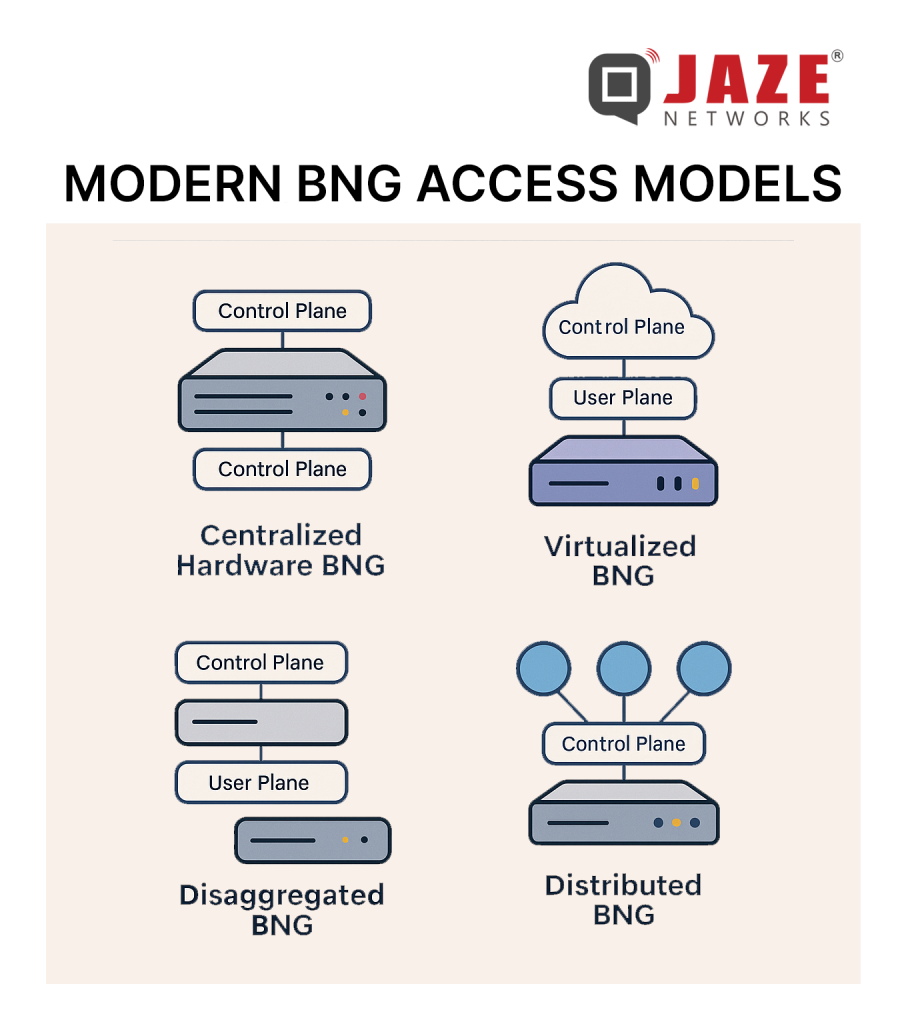
From the vantage of an ISP or a software vendor for ISPs, understanding these access models gives you strategic insight:
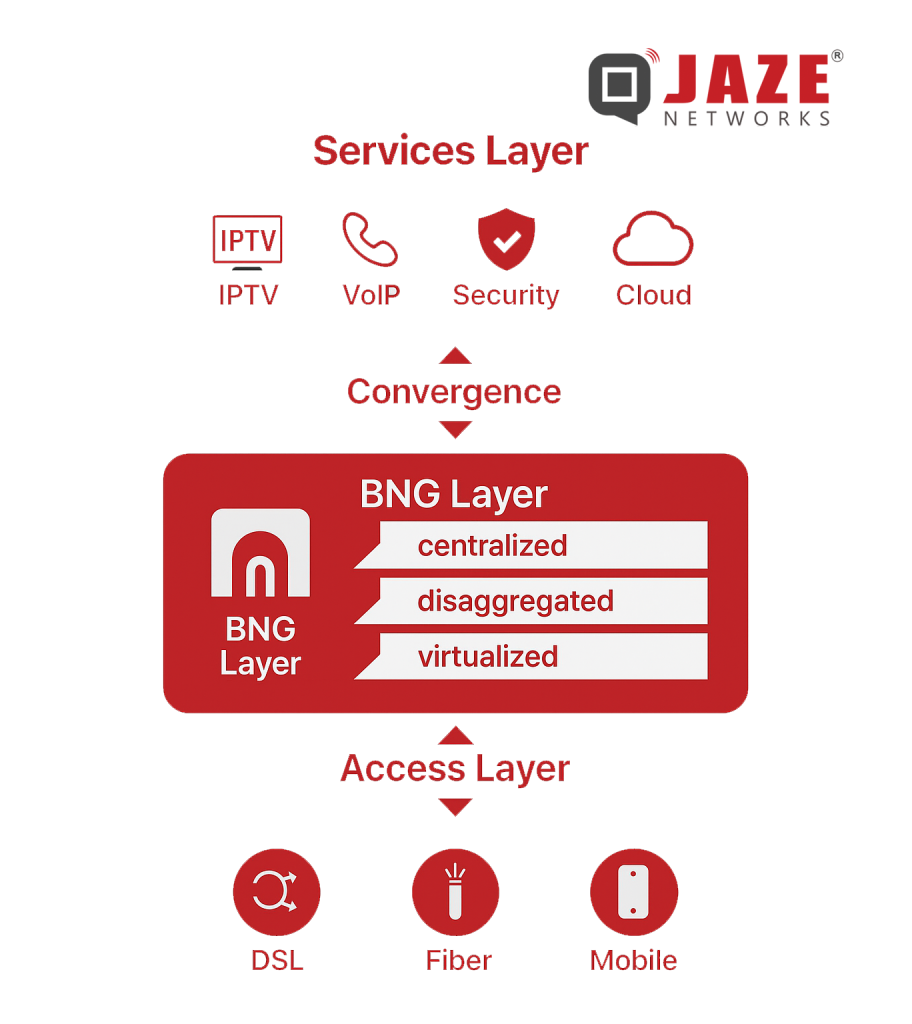
Cost efficiency & scalability: Virtualised/disaggregated BNGs reduce hardware dependency, enable scaling with demand, lower OPEX.
Service agility: Faster introduction of new pricing tiers, service bundles, new access types (FWA, WiFi) — software control matters.
Operational simplicity: Central control plane means fewer edge-appliances to manage; disaggregation means upgrades, scaling becomes less disruptive.
Edge performance & user experience: With distributed user plane, latency and backhaul loads are reduced, supporting high-quality real-time services.
Convergence & future-proofing: Fixed + wireless + multi-access handled by common architecture means ISPs are better positioned for 5G, IoT, edge-services.
Here’s a quick checklist for ISPs and software vendors to assess their BNG strategy:
Subscriber scale & growth: Can the model scale out linearly with subscriber growth and traffic loads?
Access diversity: Will your access types (fiber, FWA, WiFi) be supported under the model?
Control vs user plane location: How decoupled are they? Where will user plane be located for optimal performance?
Software orchestration & automation: Are provisioning, policy, subscriber lifecycle fully automated?
Service agility: How quickly can new tariff plans, bundles, access services be introduced?
Hardware dependency: What is the capex/opex trade-off? Can you move toward software-defined alternatives?
Edge readiness & latency: If you support real-time or OTT services, is your user plane close enough to the edge?
Vendor ecosystem & integration: Does the solution support open interfaces, multi-vendor, easier upgrades?
Whether you go for a centralised appliance, a virtualised cloud-native gateway, a disaggregated CUPS architecture or an edge-distributed model — the common theme is flexibility, software-first, multi-access readiness and subscriber-centric policy control. For ISPs and the SaaS companies that serve them, aligning your strategy (and your software platform) with these modern BNG access models means you’re not just keeping up — you’re positioning for next-gen broadband services, better user experience and operational advantage.
Jaze ISP Manager offers seamless integration with leading BNG/BRAS platforms — enabling ISPs to manage subscriber sessions, enforce policy across all access types, automate provisioning and billing, and monitor network health from one unified dashboard. Whether you are operating a traditional hardware BNG, moving to virtualised models or adopting a distributed edge architecture, Jaze ISP Manager supports the full lifecycle: from onboarding to churn, with scalability built in.
Click here to learn more.
When we talk about internet speed, most people instantly think about how fast they can download movies, stream videos, or browse social media. But in today’s world, it’s not just about downloading anymore — upload speed is equally important.
As we step into 2025–2026, when remote work, cloud storage, video creation, and smart devices dominate daily life, upload speed can make or break your digital experience.
Let’s understand why it matters — and how it affects almost everything you do online.
What Exactly Is Upload Speed?
Upload speed refers to how quickly you can send data from your device to the internet.
It’s measured in megabits per second (Mbps), just like download speed.
Every time you:
—you’re using your upload bandwidth.
If your upload speed is low, even a strong download connection can feel sluggish or unstable during these tasks.
1. The Era of Remote Work & Online Collaboration
Work-from-home and hybrid models are here to stay. Every video meeting, shared file, or cloud document relies on your upload connection.
A slow upload speed means blurry video calls, lagging audio, and constant “reconnecting…” messages — not ideal when you’re presenting to clients or attending classes online.
2. Social Media & Content Creation Boom
From influencers to small business owners, everyone is uploading photos, reels, and videos daily.
With 4K and 8K becoming standard, files are huge. High upload speed ensures your videos go live faster — and without frustrating delays.
3. Cloud Storage & Backup
We’re moving away from storing everything on devices. Automatic backups to Google Photos, iCloud, and OneDrive constantly use upload bandwidth.
If upload speeds are low, backups slow down, sync fails, and your data may remain outdated.
4. Smart Homes & IoT Devices
Cameras, sensors, and voice assistants send continuous data to cloud servers.
When upload bandwidth is insufficient, you’ll see camera feed delays, failed device syncs, or unreliable smart automation.
5. Gaming & Live Streaming
Gamers know the pain of lag.Online gaming and live streaming both rely on strong upstream connections — every action, every frame, every voice chat goes out through your upload channel.
Higher upload speeds mean smoother gameplay and crystal-clear streams.
| Online Activity | Recommended Upload Speed |
| Video calls (Zoom, Meet) | 3–5 Mbps |
| Cloud backups | 10–20 Mbps |
| Online gaming | 5–10 Mbps |
| 4K live streaming | 20–25 Mbps |
| Uploading large media files | 25 Mbps and above |
If multiple devices or users share the same connection, you’ll need even higher speeds for a seamless experience.

India’s internet usage pattern is shifting fast. Earlier, most users were consumers of content — watching, downloading, or streaming.
But now, millions are creators — students uploading projects, professionals hosting webinars, and entrepreneurs managing online stores.
Unfortunately, many broadband plans in India still prioritize download speeds and offer much lower uploads (often just 10–20% of download rates).
That imbalance is slowly changing, as fiber networks and symmetrical connections become mainstream.
Traditional broadband (like copper or DSL) can’t handle equal upload and download speeds.
But fiber-to-the-home (FTTH) connections deliver symmetrical speeds — meaning if you get 200 Mbps download, you also get 200 Mbps upload.
This makes a huge difference for:
Fiber technology is the backbone of India’s digital growth — and it’s finally bridging the upload gap.
As India embraces a creator-driven digital economy, upload speed is no longer secondary — it’s essential.
Whether you’re working from home, managing an online business, or sharing your creativity with the world, faster upload speeds ensure smoother, smarter, and more reliable connectivity.
Jaze ISP Manager helps ISPs by optimising bandwidth delivery and provide a seamless experience to subscribers. This ensures stable upload speeds for users, reduces congestion during peak hours, and improves performance for video calls, cloud backups, and live streaming. In short, it gives ISPs the tools to maintain reliable upstream performance for their customers. Click here to know more
India’s digital transformation has been one of the most significant global stories of the past decade. With over 820 million internet users, the country has emerged as a digital-native economy, despite having a GDP per capita of just over $2,700. While many countries transitioned gradually from desktops to smartphones, India skipped a few steps—embracing mobile-first access from the start.
This shift isn’t just about personal connectivity—it’s reshaping how industries operate, especially the business events sector. To stay relevant and future-ready, industry players must understand the implications of India’s digital adoption and build strategies around it.
India’s digital growth is powered by affordable smartphones and low-cost data plans, making internet access more democratic and widespread.
This has created an environment where digital content, platforms, and tools are more relevant than traditional, hardware-intensive solutions.
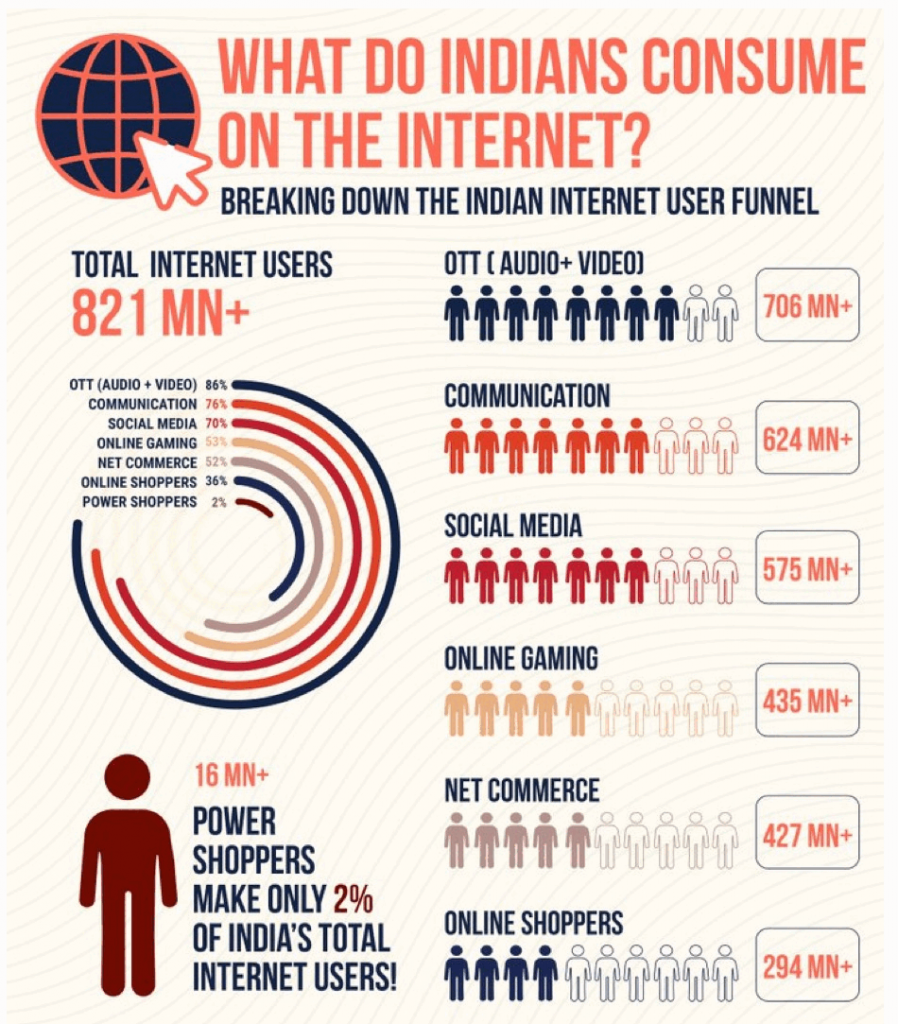
The nature of India’s digital access changes how audiences engage with content and events. Traditional formats no longer suffice. Instead, digital-first strategies must become central to event planning, marketing, and execution.
Here are three key ways the business events industry can evolve:
Event organisers must think beyond the physical venue. With millions of people accessing content via mobile phones, the potential reach is enormous—if content is tailored and distributed effectively.
Modern venues must support more than Wi-Fi. They need to enable seamless content creation, hybrid streaming, and sustainable practices powered by digital infrastructure.
Vendors—whether tech providers, production partners, or logistics firms—play a crucial role in helping organisers and venues bridge the digital gap.
To build an inclusive, sustainable events industry in India, stakeholders must experiment with digital technologies at every level—from promotion and operations to post-event analysis.
India’s digital-first population presents an incredible opportunity—but only for those prepared to adapt. Organisers, venues, and vendors must rethink their roles and responsibilities in a mobile-led world. By embracing digital tools, supporting inclusive infrastructure, and prioritizing sustainability, the business events industry can truly evolve to serve India’s next billion internet users.
As digital connectivity becomes central to every industry, Internet Service Providers must modernize how they operate.
Jaze ISP Manager helps ISPs manage their broadband business with ease—offering automated customer support, real-time network monitoring, intelligent fault detection, and direct revenue sharing between franchises. It’s a complete solution designed to improve reliability, simplify operations, and support scale, especially in mobile-first markets like India.
Click here to know more.
In recent years, India’s Over-the-Top (OTT) sector has witnessed exponential growth, transforming the way content is consumed across the nation. With the advent of affordable internet and the proliferation of smartphones, OTT platforms have become the go-to source for entertainment, news, and more. But Who Dominates India’s OTT Sector?
India’s OTT landscape is dominated by a few key players, each bringing something unique to the table. The most prominent platforms include Disney+ Hotstar, Amazon Prime Video, Netflix, and JioCinema. These platforms have carved out significant market shares by offering a diverse range of content tailored to the varied tastes of Indian audiences.
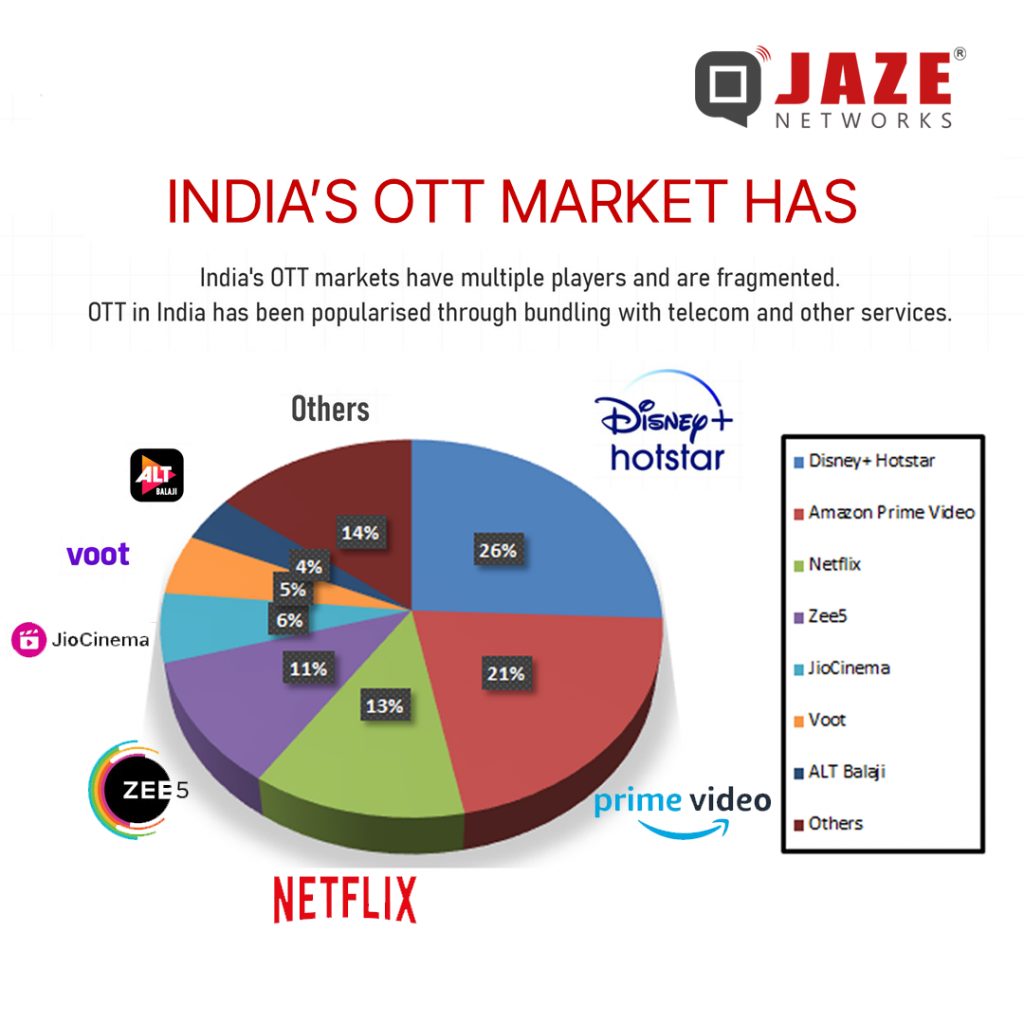
Disney+ Hotstar leads the pack with its extensive library of local and international content, including exclusive rights to stream major sports events like the Indian Premier League (IPL). This has made it a household name, especially among sports enthusiasts.
Amazon Prime Video follows closely, known for its vast collection of movies, TV shows, and original content. The platform’s investment in regional content has paid off, attracting a broad audience base across different linguistic demographics.
Netflix, while a global giant, has tailored its strategy to cater to Indian viewers by producing high-quality local content and acquiring rights to popular Bollywood films. Its focus on original series and movies has helped it gain a loyal subscriber base.
JioCinema, backed by Reliance Jio, leverages its extensive telecom network to offer affordable streaming services. Its integration with Jio’s telecom services provides a seamless experience for users, making it a strong contender in the market.
The Indian OTT market is characterized by its rapid growth and dynamic nature. As of 2024, the market is expected to exceed $10 billion, with over 500 million active users. This growth is driven by several factors:
Despite the optimistic outlook, the OTT sector faces challenges, including:
However, these challenges also present opportunities. The increasing demand for on-demand content and the integration of advanced technologies like AI and blockchain can help platforms differentiate themselves and offer unique value propositions to their users.
The future of India’s OTT sector looks promising. With the continuous rise in internet penetration and the growing preference for digital content, the market is poised for further expansion. Platforms that can innovate and adapt to the evolving preferences of Indian viewers will likely emerge as leaders in this space.
As the market continues to expand, driven by technological advancements and changing consumer behaviors, platforms that prioritize content diversity, user experience, and strategic partnerships are likely to maintain a competitive edge in this burgeoning industry.
Today all ISPs need to provide OTT services as a value add-on to retain subscribers and improve customer satisfaction. Jaze ISP manager integrates with all leading OTT platforms and OTT aggregators to automate billing for OTT services as well as activate and deactivate OTT services directly without manual intervention. Click here to learn more.
As of 2023, TRAI has highlighted quality of service (QoS) issues as a persistent concern among Indian consumers, with complaints regarding network disruptions, inconsistent speeds, and hidden fees. TRAI receives thousands of complaints monthly, which indicates widespread dissatisfaction with service quality and transparency in ISP billing practices.
A reliable internet connection is as essential as electricity in today’s digital age. Complaints about poor service quality, hidden charges, and inconsistent speeds are widespread. Understanding if you’re getting your money’s worth from your ISP is crucial. Let’s dive into the ways to determine if your ISP is delivering on its promises.
India’s internet landscape shows a stark contrast in accessibility between urban and rural areas. While urban consumers enjoy more ISP options and higher speeds, rural areas still struggle with connectivity. The rural broadband penetration rate is significantly lower than urban, as per TRAI reports, making it challenging for rural consumers to switch to better providers or find competitive prices. This disparity limits consumer choices and leads to dissatisfaction among rural users, who feel locked into subpar services due to a lack of alternatives.
As India’s internet needs grow, consumers deserve ISPs that provide transparent pricing, reliable speeds, and better access across the country.
Jaze ISP Manager helps ISPs streamline operations with feature-rich and configurable modules including lead management, helpdesk, customer portals and mobile applications in order to help serve customers better. These features ensure reliable service delivery and support to provide a great customer experience. Click here to know more.
A Content Delivery Network (CDN) is a distributed group of servers spread across various geographic locations, working together to efficiently deliver Internet content. The primary role of a CDN is to enhance the speed, availability, and security of websites by serving content closer to the user.
CDNs are widely used to transfer web assets like HTML pages, JavaScript files, stylesheets, images, and videos. The growing reliance on CDN services means that a significant portion of today’s web traffic, including content from major platforms like Netflix, Amazon, and Facebook, is delivered via CDNs.
The key to a CDN’s functionality lies in its geographically distributed network of servers. Here’s a simplified overview of how a CDN works:
By distributing content in this way, CDNs are able to significantly enhance the performance and reliability of websites.
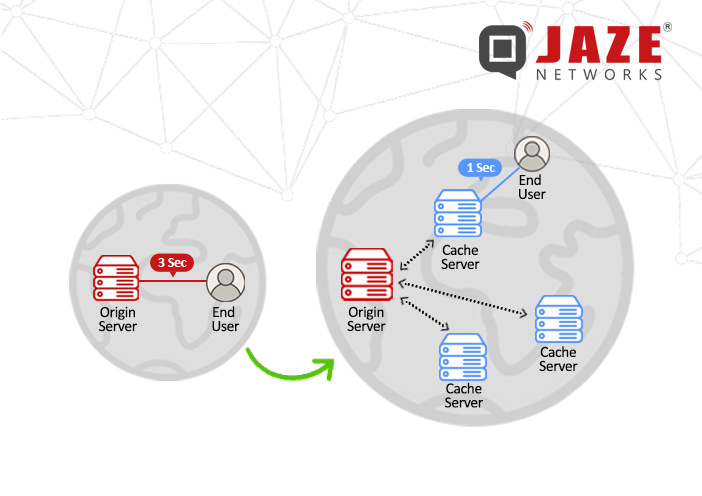
The advantages of using a CDN can vary depending on the size and needs of the website or application. However, the four primary benefits of a CDN are:
One of the biggest expenses for websites is the cost of bandwidth consumption for hosting. CDNs help reduce these costs by caching content, thereby reducing the load on the origin server. Since the CDN handles a significant portion of traffic, website owners can save on bandwidth expenses, making their operations more cost-efficient.
Websites often face the challenge of handling sudden spikes in traffic or dealing with hardware failures. A CDN, with its distributed infrastructure, can easily manage large volumes of traffic and better withstand hardware failures. This ensures that the website remains accessible even under heavy load, improving uptime and reliability.
Speed is a crucial factor for user experience. By serving content from servers that are closer to the end user, CDNs significantly reduce latency and enhance page load times. Faster loading websites are less likely to lose visitors due to slow performance, leading to reduced bounce rates and increased engagement. Studies show that users are more likely to leave a website if it takes too long to load, so CDNs play a vital role in improving visitor retention and satisfaction.
CDNs offer a range of security features, such as DDoS (Distributed Denial of Service) mitigation, improved SSL (Secure Sockets Layer) certificates, and other security optimizations. By distributing traffic across multiple servers, a CDN can help protect a website from DDoS attacks, where a server is overwhelmed by a flood of traffic. Additionally, by keeping malicious traffic away from the origin server, a CDN reduces the risk of cyberattacks and ensures that sensitive data is better protected.
CDNs play a vital role in the modern internet ecosystem by ensuring that web content is delivered quickly, reliably, and securely. Whether you’re running a small blog or a large e-commerce site, leveraging a CDN can provide significant benefits in terms of performance, cost savings, and security.
Most of the large CDN networks are available through peering at IXs. This helps ISPs who peer with them to significantly reduce bandwidth costs and deliver content faster. Jaze ISP Manager integrates with all leading BNGs which support multiple QoS policies to prioritize CDN traffic over other traffic streams. Click here to learn more
The landscape of entertainment and media consumption in India is poised for a significant transformation, with online video consumption expected to soar in the coming years. According to a recent report by Bain & Company, the nation is on the brink of a digital revolution, with a surge in broadband penetration driving the proliferation of online video content.
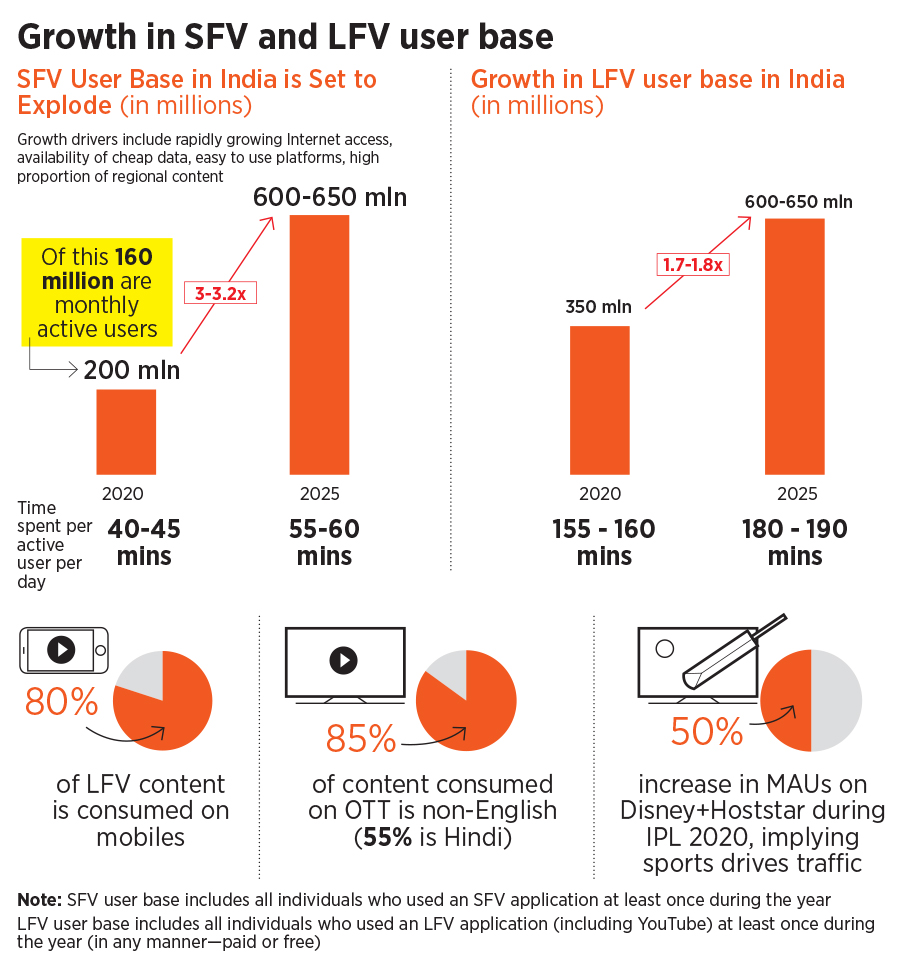
The report attributes this growth to several factors, including:
Broadband Expansion: The rapid growth of broadband infrastructure in urban and rural areas is a key driver.
Affordability Boost: The increasing affordability of smartphones and smart devices is democratising access to online video content.
Content Explosion: A wide variety of video streaming platforms offer diverse content libraries.
Two broad categories of online video consumption are:
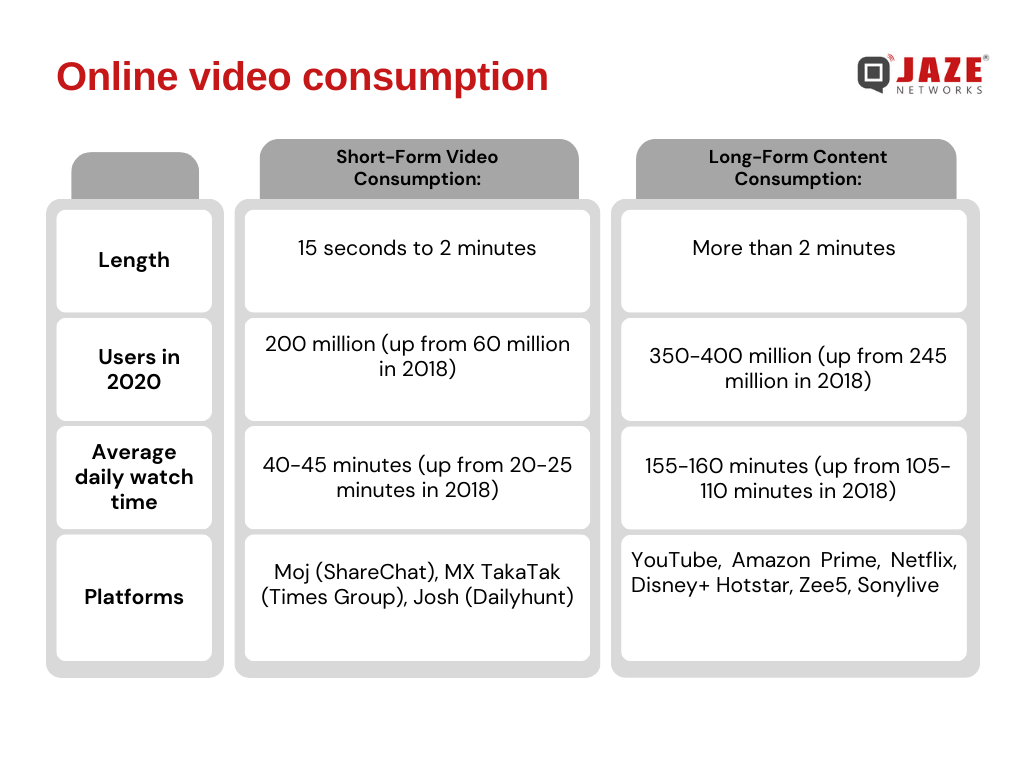
The top 5 players in the SFV market—Moj (ShareChat), MX TakaTak (TimeGroup), Josh (Dailyhunt), Roposo (Glance), and Zili (Xiaomi)—account for 85% of monthly active users amongst SFV platforms. Meanwhile, the creator base for SFV is scaling in India.
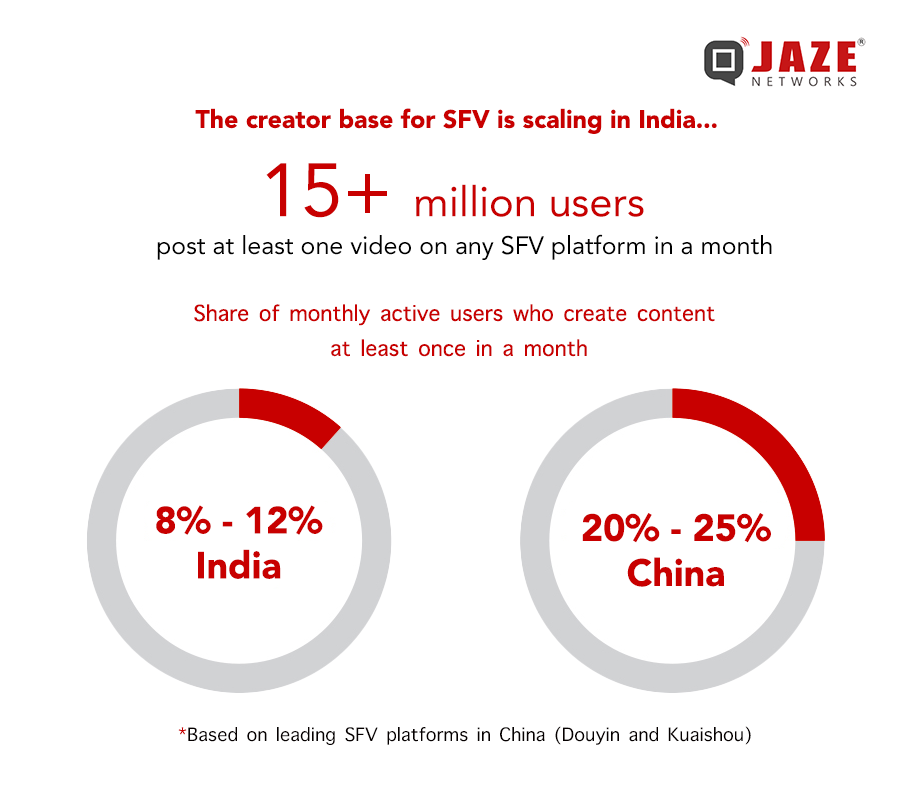
The report’s findings are positive news for the Indian media and entertainment industries. Online video is a growing source of revenue for media companies, and the expected surge in consumption is likely to lead to increased investment in online video content. This, in turn, will benefit both viewers and content creators alike.
To accommodate the rising demand for bandwidth caused by the surge in video consumption, Internet Service Providers (ISPs) require larger routers and Broadband Network Gateways (BNGs). Jaze ISP Manager addresses this need by seamlessly integrating leading hardware and software BNG providers. This integration facilitates the delivery of broadband services featuring flexible plans bundled with Over-The-Top (OTT) services, all offered at competitive pricing.
Click here https://www.jazenetworks.com/jaze-isp-manager/ to learn more about automating your business processes and streamlining operations with Jaze ISP Manager.